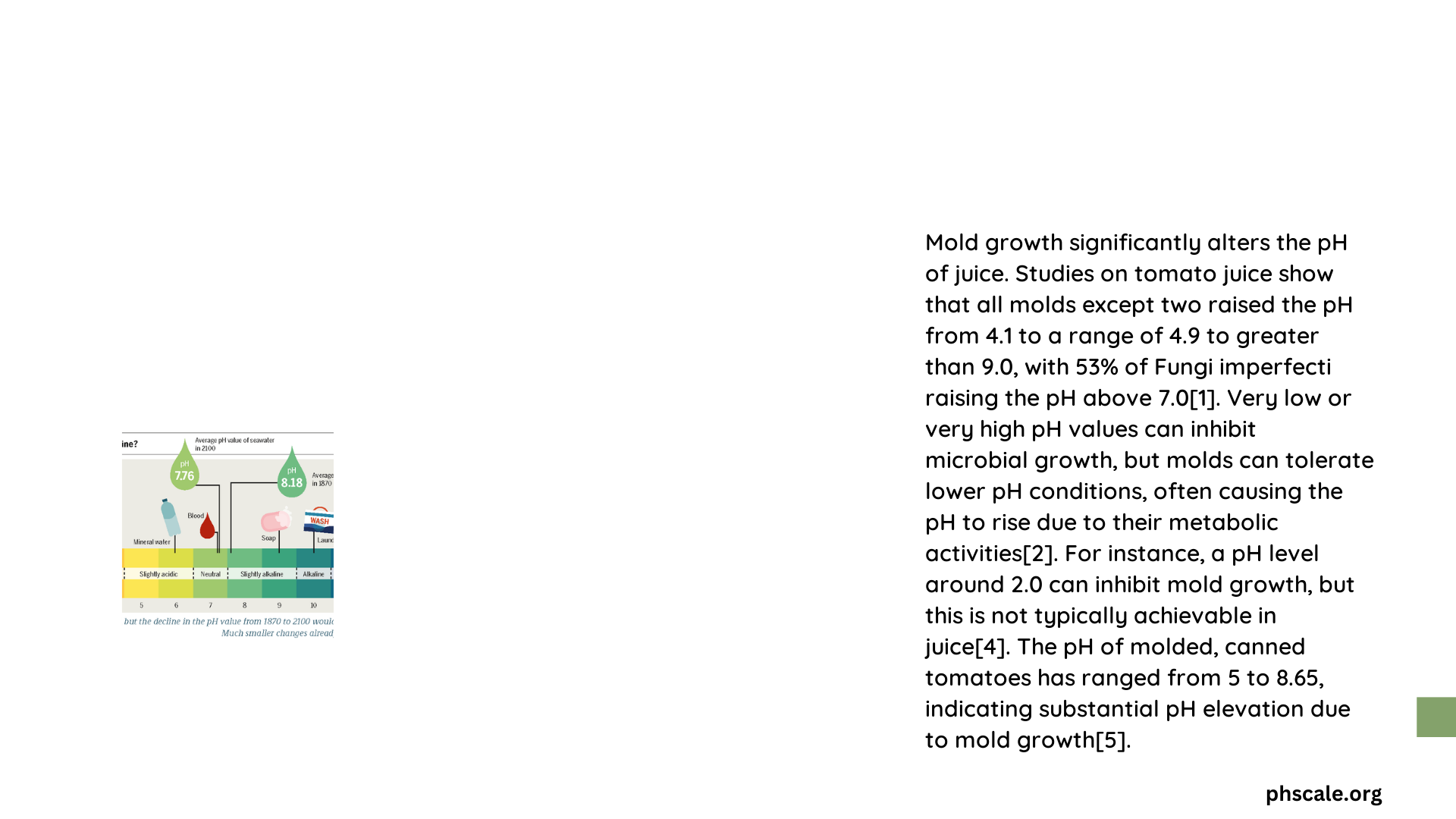The pH level in fruit juices plays a crucial role in determining the potential for mold growth and spoilage. Most fruit juices are naturally acidic, with pH values ranging from 3.0 to 4.5. This acidity acts as a natural preservative, inhibiting the growth of many microorganisms. However, some molds can tolerate and even thrive in these acidic conditions, making pH management a critical factor in juice preservation and safety.
What is the Typical pH Range for Fruit Juices?
Fruit juices generally fall within the acidic range of the pH scale. Here’s a breakdown of common fruit juice pH levels:
- Orange juice: 3.5 – 4.0
- Apple juice: 3.3 – 4.0
- Grape juice: 3.0 – 4.0
- Lemon juice: 2.0 – 2.6
- Cranberry juice: 2.3 – 2.5
- Pineapple juice: 3.3 – 3.6
These acidic pH levels contribute to the tart flavor of many juices and serve as a natural defense against some forms of microbial growth.
How Does pH Affect Mold Growth in Juices?

The relationship between pH and mold growth in juices is complex:
- pH Tolerance: Most molds prefer slightly acidic to neutral environments (pH 4.6 – 7.0) for optimal growth.
- Growth Thresholds: Many molds can grow at pH levels as low as 4.2 to 4.4, but growth is significantly inhibited below pH 4.6.
- Adaptation: Some mold species can adapt to acidic environments and even alter the pH of their surroundings to create more favorable conditions.
Table: Mold Growth in Relation to pH
| pH Range | Mold Growth Potential |
|---|---|
| < 4.0 | Minimal growth |
| 4.0 – 4.6 | Limited growth |
| 4.6 – 7.0 | Optimal growth |
| > 7.0 | Reduced growth |
Which Mold Species Commonly Affect Acidic Juices?
Certain mold species are particularly adept at surviving and growing in acidic juice environments:
- Aspergillus species
- Penicillium species
- Eurotium species
- Byssochlamys species
These molds are often responsible for juice spoilage and can produce mycotoxins, potentially harmful compounds that can affect human health.
What Are Effective Methods to Prevent Mold Growth in Acidic Juices?
Preventing mold growth in juices involves a multi-faceted approach:
- pH Management:
- Maintain pH below 4.6 through natural acidity or addition of food-grade acids
-
Monitor pH levels regularly during production and storage
-
Temperature Control:
- Refrigerate juices promptly after production
-
Maintain cold chain during distribution and storage
-
Preservatives:
- Use approved preservatives like potassium sorbate or sodium benzoate
-
Ensure proper concentration and even distribution in the juice
-
Processing Techniques:
- Pasteurization to eliminate existing mold spores
-
Aseptic packaging to prevent post-processing contamination
-
Hygiene Practices:
- Implement strict sanitation protocols in production facilities
- Use clean, sanitized equipment and packaging materials
How Does Water Activity Interact with pH in Juice Preservation?
Water activity (aw) works synergistically with pH to control microbial growth:
- Low pH (high acidity) + Low aw = Enhanced microbial control
- Most molds require aw > 0.80 for growth
- Reducing water activity through concentration or addition of solutes (e.g., sugar) can further inhibit mold growth
What Are the Implications of pH on Juice Shelf Life and Safety?
The pH of juice significantly impacts its shelf life and safety:
- Shelf Life Extension: Lower pH juices generally have longer shelf lives due to reduced microbial activity.
- Pathogen Control: pH < 4.6 inhibits growth of many pathogenic bacteria, enhancing juice safety.
- Quality Preservation: Proper pH management helps maintain juice color, flavor, and nutritional value.
- Regulatory Compliance: Many food safety regulations require pH < 4.6 for shelf-stable juices.
How Can Consumers Identify Potential Mold Growth in Juices?
Signs of mold growth in juices include:
- Visible mold growth on juice surface or container
- Off-odors or musty smells
- Changes in juice color or texture
- Unusual fermentation or gas production
Consumers should discard any juice showing these signs, regardless of the expiration date.
What Recent Innovations Address pH and Mold Control in Juices?
Recent advancements in juice preservation include:
- Natural antimicrobial compounds from plant extracts
- High-pressure processing (HPP) for cold pasteurization
- Pulsed electric field (PEF) treatment
- Ultrasound technology for microbial inactivation
- Smart packaging with pH indicators
These technologies aim to maintain juice quality while ensuring safety and extending shelf life.
Understanding the relationship between pH in juice and mold growth is crucial for both producers and consumers. By managing pH levels, implementing proper preservation techniques, and staying vigilant for signs of spoilage, we can enjoy safe, high-quality fruit juices while minimizing the risk of mold contamination.
References:
1. https://docs.neu.edu.tr/library/6813738064.pdf
2. https://aqualab.com/en/knowledge-base/expertise-library/how-water-activity-and-ph-work-together-control-microbial
3. https://extension.okstate.edu/fact-sheets/the-importance-of-food-ph-in-commercial-canning-operations.html
